ZNF131 suppresses centrosome fragmentation in glioblastoma stem-like cells through regulation of HAUS5
- PMID: 28596487
- PMCID: PMC5564707
- DOI: 10.18632/oncotarget.18153
ZNF131 suppresses centrosome fragmentation in glioblastoma stem-like cells through regulation of HAUS5
Abstract
Zinc finger domain genes comprise ~3% of the human genome, yet many of their functions remain unknown. Here we investigated roles for the vertebrate-specific BTB domain zinc finger gene ZNF131 in the context of human brain tumors. We report that ZNF131 is broadly required for Glioblastoma stem-like cell (GSC) viability, but dispensable for neural progenitor cell (NPC) viability. Examination of gene expression changes after ZNF131 knockdown (kd) revealed that ZNF131 activity notably promotes expression of Joubert Syndrome ciliopathy genes, including KIF7, NPHP1, and TMEM237, as well as HAUS5, a component of Augmin/HAUS complex that facilitates microtubule nucleation along the mitotic spindle. Of these genes only kd of HAUS5 displayed GSC-specific viability loss. Critically, HAUS5 ectopic expression was sufficient to suppress viability defects of ZNF131 kd cells. Moreover, ZNF131 and HAUS5 kd phenocopied each other in GSCs, each causing: mitotic arrest, centrosome fragmentation, loss of Augmin/HAUS complex on the mitotic spindle, and loss of GSC self-renewal and tumor formation capacity. In control NPCs, we observed centrosome fragmentation and lethality only when HAUS5 kd was combined with kd of HAUS2 or HAUS4, demonstrating that the complex is essential in NPCs, but that GSCs have heightened requirement. Our results suggest that GSCs differentially rely on ZNF131-dependent expression of HAUS5 as well as the Augmin/HAUS complex activity to maintain the integrity of centrosome function and viability.
Keywords: Augmin/HAUS complex; HAUS5; ZNF131; cancer therapeutics; glioblastoma.
Conflict of interest statement
The authors disclose no potential conflicts of interest.
Figures
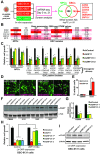
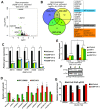
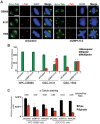


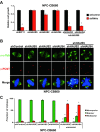
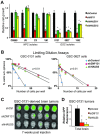
Similar articles
-
HAUS, the 8-subunit human Augmin complex, regulates centrosome and spindle integrity.Curr Biol. 2009 May 26;19(10):816-26. doi: 10.1016/j.cub.2009.04.033. Epub 2009 May 7. Curr Biol. 2009. PMID: 19427217
-
SRSF3-Regulated RNA Alternative Splicing Promotes Glioblastoma Tumorigenicity by Affecting Multiple Cellular Processes.Cancer Res. 2019 Oct 15;79(20):5288-5301. doi: 10.1158/0008-5472.CAN-19-1504. Epub 2019 Aug 28. Cancer Res. 2019. PMID: 31462429 Free PMC article.
-
Genome-wide RNAi screens in human brain tumor isolates reveal a novel viability requirement for PHF5A.Genes Dev. 2013 May 1;27(9):1032-45. doi: 10.1101/gad.212548.112. Genes Dev. 2013. PMID: 23651857 Free PMC article.
-
CD133 as a marker for regulation and potential for targeted therapies in glioblastoma multiforme.Neurosurg Clin N Am. 2012 Jul;23(3):391-405. doi: 10.1016/j.nec.2012.04.011. Epub 2012 Jun 5. Neurosurg Clin N Am. 2012. PMID: 22748652 Review.
-
The role of octamer binding transcription factors in glioblastoma multiforme.Biochim Biophys Acta. 2016 Jun;1859(6):805-11. doi: 10.1016/j.bbagrm.2016.03.003. Epub 2016 Mar 8. Biochim Biophys Acta. 2016. PMID: 26968235 Free PMC article. Review.
Cited by
-
Identification and Pharmacological Targeting of Treatment-Resistant, Stem-like Breast Cancer Cells for Combination Therapy.bioRxiv [Preprint]. 2025 Feb 12:2023.11.08.562798. doi: 10.1101/2023.11.08.562798. bioRxiv. 2025. PMID: 38798673 Free PMC article. Preprint.
-
FBXO42 activity is required to prevent mitotic arrest, spindle assembly checkpoint activation and lethality in glioblastoma and other cancers.NAR Cancer. 2024 May 20;6(2):zcae021. doi: 10.1093/narcan/zcae021. eCollection 2024 Jun. NAR Cancer. 2024. PMID: 38774470 Free PMC article.
-
Comprehensive analysis of the correlation of the pan-cancer gene HAUS5 with prognosis and immune infiltration in liver cancer.Sci Rep. 2023 Feb 10;13(1):2409. doi: 10.1038/s41598-023-28653-6. Sci Rep. 2023. PMID: 36765148 Free PMC article.
-
Neural G0: a quiescent-like state found in neuroepithelial-derived cells and glioma.Mol Syst Biol. 2021 Jun;17(6):e9522. doi: 10.15252/msb.20209522. Mol Syst Biol. 2021. PMID: 34101353 Free PMC article.
-
Identification and validation of ubiquitination-related signature and subgroups in immune microenvironment of tuberculosis.Aging (Albany NY). 2023 Nov 9;15(21):12570-12587. doi: 10.18632/aging.205198. Epub 2023 Nov 9. Aging (Albany NY). 2023. PMID: 37950733 Free PMC article.
References
-
- American Cancer Society American Cancer Society: Cancer Facts and Figures. 2010.
-
- Stupp R, Mason WP, van den Bent MJ, Weller M, Fisher B, Taphoorn MJ, Belanger K, Brandes AA, Marosi C, Bogdahn U, Curschmann J, Janzer RC, Ludwin SK, et al. Radiotherapy plus concomitant and adjuvant temozolomide for glioblastoma. N Engl J Med. 2005;352:987–96. doi: 10.1056/NEJMoa043330. - DOI - PubMed
-
- Singh SK, Clarke ID, Terasaki M, Bonn VE, Hawkins C, Squire J, Dirks PB. Identification of a cancer stem cell in human brain tumors. Cancer Res. 2003;63:5821–8. - PubMed
-
- Singh SK, Hawkins C, Clarke ID, Squire JA, Bayani J, Hide T, Henkelman RM, Cusimano MD, Dirks PB. Identification of human brain tumour initiating cells. Nature. 2004;432:396–401. - PubMed
MeSH terms
Substances
Grants and funding
LinkOut - more resources
Full Text Sources
Other Literature Sources
Medical
Molecular Biology Databases
Research Materials

